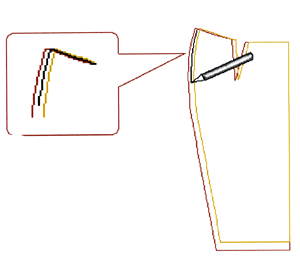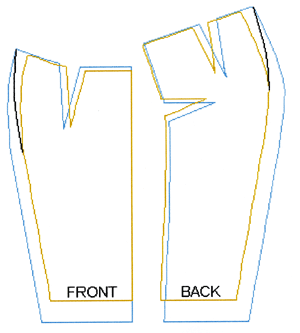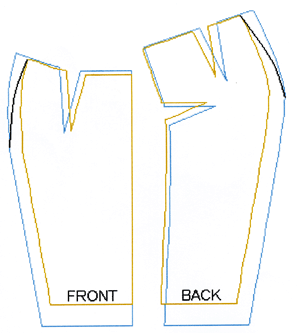Pages to read before using the patterns:
Easy adaptions of the patterns
Because it is difficult to have too many sizes on one pattern, we have chosen to have only 5 (men) or 6 (women) sizes per pattern. This means that we have had to skip every second size. If you require an in-between size then simply draw a new pattern between the lines of the existing pattern, following the same lines and contours, of the smaller and larger size. This works for all patterns, both men’s and women’s.
For one size waist and larger size hip, draw the contoured line connecting the points of the smaller size waist to the larger size hip. Do this on both front and back pieces.
For one size smaller hips, and a larger size waist, draw a contoured line connecting the points of the larger size waist to the smaller size hips. Do this on both front and back pieces. 
To make a skirt shorter, measure how much you want to take off and mark it out on both front and back pieces. Remember to leave enough for seam allowance otherwise your skirt may become too short.
To make a skirt longer you will also need to widen it a little from the hip line as well as lengthen it. You may also have to add splits in the side seam/s or back seam.
To make pants shorter, measure how short you want them to be. Remember to add seam allowance so your pants do not get too short. Mark out the measurements on both front and back piece. You can also make 3/4 length pants and shorts from this pattern.
To make the pants longer, measure the length required and adds it to the bottom. Remember to add seam allowance and continue the line of the pants.







Hej!
Jag håller på med att sy en kjol med slits (köpt ett mönster).
Jag vill korta av kjolen, finns markeringar var man gör det.
Nu undrar jag: ska jag flytta ned slitsen lika många cm som jag kortar av kjolen? I annat fall blir väl slitsen högre upp, om jag förstått rätt.
Tacksam för hjälp
MVH
Gunilla
Ska du inte korta av kjolen i nederkanten???
Om du kortar högre upp – ovanför slitsen – så flyttas den uppåt så du behöver nog “flytta ned” den. Svårt att ge svar när jag inte ser mönstret.
It is absolutely critical to have stretch fabric for the seat and waist of trousers for comfort, fit, prevention of wrinkles and so pain causing darts can be avoided to create a seated shape. Any tips for adapting non stretch trousers to have replacement stretch backs from say behind the knee upwards? Better still any tips to also reduce the length at the front waist too (too much fabric and up under the nipples to complement the lengthening at the back?
This would allow me to adapt my wardrobe full of fine mens wool trousers instead of wearing only womens woven fabric stretch jeans.
Our patterns are actually shaped to a seated position – the legs and body part of them are put on an angle instead of set in a straight line – so tucks is not optional if your using our pants’ pattern. They are not the adaptation in itself but a consequence of it. So if you want to use our pants pattern they don’t work without the tucks (darts). Lengthening the back and/or shortening the front of pants will not make them fit you in a seated position. You will still have the wrinkles and pain of fabric pulling pants backwards in the crotch area. This is because “normal” pants patterns are designed for a standing body.
Our adaptions are also made for a seated body so the tucks and seams you see in these are also consequences of the lengthened back AND angled pants body part.
We have looked into a solution (not an adaptation but a pattern) where the back of the pants – down to below the sit bones (Ischial Tuberosity) – would be replaced by elastic fabric (in our solution we still had the angle though so the tucks (darts) at least in the sides would have been a part of it). The main problem we saw was that we would still have the seams (especially where the elastic fabric and the front pants’ fabric met) and they were tricky to position so they didn’t cause pressure sores. We didn’t talk about as long a piece as to the knees though, but wherever the seam connecting elastic to non-elastic fabric would be could cause a problem since it would be across the back of the pants. Your thinking of a piece down to the knees is probably the most doable.
However, if you want to adapt an existing pair of pants the adaptation piece will have to be sewn in not just across the back of the knees, but along the side seams and more problematically the crotch seam. We couldn’t see how this could be done without causing real issues (damage). Adapting the front can be done by simply loosen the waist band and remove a curved pieces of the front pants fabric, then resowing the waistband. However this will mean you must lengthen the waistband.
I will put your wish for a solution of this kind on our list but I can’t promise you that we can provide a solution – or whether it is something we can look into under our ongoing project (brief decides what we promised to do for the money we’ve received).
Sorry I can’t be to more help. /Susanne
Than you for these patterns and detailed reply including consideration of pressure sores. I can’t express how grateful I am for this!!! Looking forward to finally making some pants that fit him after 26yrs of baggy trackies.
Do u have a pattern for open backed trousers for female MS wheelchair sufferer?
Really would appreciate some help
Thank you
I appreciate all the work you’ve done to made adaptive clothing. I am an experienced sewer (taught professional sewing methods to home sewers for several years) and even I have to learn now to make open back clothing. You are so right that clothes are designed mostly for standing figures. I will use your patterns for my M-i-L who is not in a wheelchair and needs open back garments.
I have one comment on a line in your response to Chet. I think this is a typo, as the word “sown” refers to sowing seeds, but in sewing, the past perfect is “sewn” It’s not a big deal, but it may provide clarification for a gardener-turned tailor!
“However, if you want to adapt an existing pair of pants the adaptation piece will have to be sown in not just across the back of the knees…”